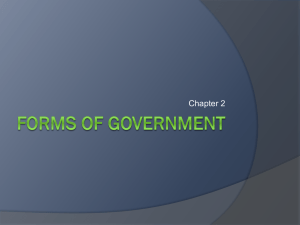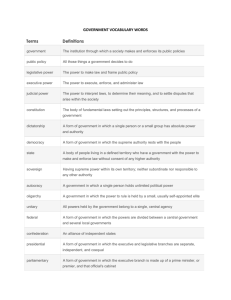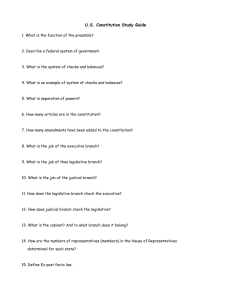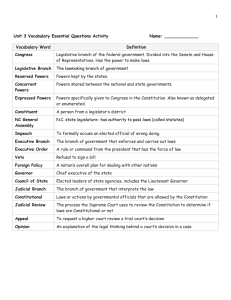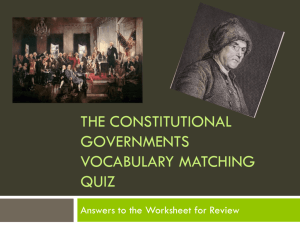Chapter 3 Forms of Government
advertisement
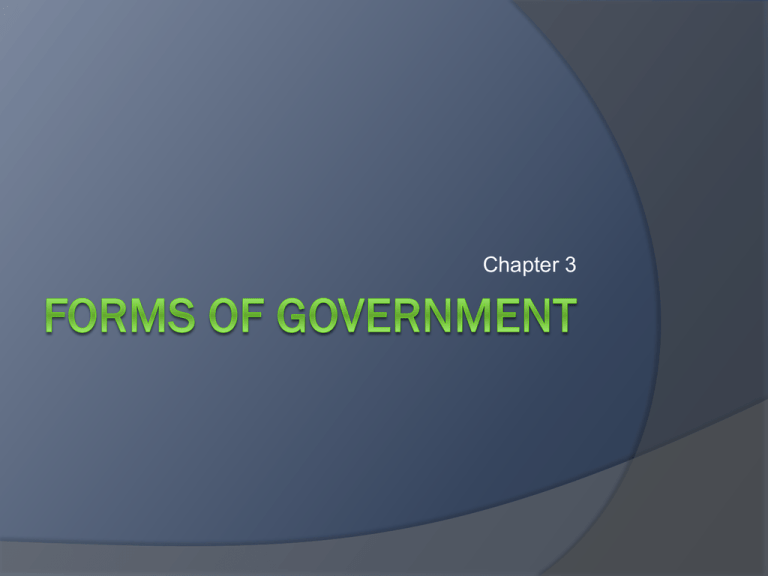
Chapter 3 Types of Government Three ways to classify governments: 1. Systems of government 2. Relationship between levels of government 3. Methods of selecting the executive Systems of Government Popular government Democracy ○ Direct Democracy ○ Indirect Democracy Republic Dictatorship Anarchy Popular Governments The people participate. Direct democracy – people directly affect government’s policies & actions Very rare today “Today direct democracy is rare because of geographic and population limitations.” Agree or disagree? Popular Governments Indirect democracy – people choose their peers to operate government on their behalf (or REPRESENT them). Republic – “a state in which the supreme power rests in the people and their elected representatives or officers. Dictatorship In a dictatorship, the government acts without the consent of the people. Totalitarianism- a ruling class holds absolute power and seeks to exercise control over every aspect of people’s lives. Autocracy – rule by 1 person with supreme authority Oligarchy – rule by an elite group Anarchy An absence of government Because of human depravity, typically anarchy, instead of leading to maximum liberty, leads to a state of lawlessness. Jeremiah 17:9 The heart is deceitful above all things, and desperately wicked: who can know it? Types of Government Three ways to classify governments: 1. Systems of government 2. Relationship between levels of government Relationship Between Levels of Government 1. Unitary 2. Federal 3. Confederate Relationship Between Levels of Government Unitary Governments Power resides in central government All power from the people (unlike dictatorship) Local units may help administer government. Examples: Great Britain, Japan, France, Israel Relationship Between Levels of Government Federal Governments – Federalism Power is divided among national, regional, and local governments. Usually governed by a constitution which specifies the powers and responsibilities of each level. Examples: United States, Brazil, India Relationship Between Levels of Government Confederate Governments Regional governments retain supremacy and delegate some tasks to the national government. Examples: Articles of Confederation, Confederate States of America, European Union (EU) Types of Government Three ways to classify governments: 1. Systems of government 2. Relationship between levels of government 3. Methods of selecting the executive Methods of Selecting the Executive Presidential System – people directly elect the president. Question: Do the people directly elect the President of the United States? Answer: No. The Electoral College elects the president. Methods of Selecting the Executive Parliamentary System People elect their representatives to Parliament. ○ Candidate of the party with the most votes in each district wins. The majority party in the parliament chooses the executive (prime minister). Examples: Great Britain, France, Japan, Indonesia Which system is better: Presidential or Parliamentary? p. 37 Types of Government by System List and explain. Levels of American Government National State Local National Government The U.S. Constitution LIMITS the power of the national government by allowing it to have certain DELEGATED POWERS. National Government Legislative Branch Executive Branch Judicial Branch Legislative Branch Makes the laws Closest ties to the people: directly elected Two houses House of Representatives Senate Executive Branch Enforces the laws President Vice President Advisors ○ EOP ○ Cabinet Judicial Branch Interprets the laws Are the laws passed by Congress and the states consistent with the Constitution? Supreme Court Lower Courts State Government Fifty (50) states States keep all power not delegated to the national government (RESERVED POWERS) or prohibited to the states by the Constitution (PROHIBITED POWERS). States all have their own constitutions. State Government Reserved Powers– 10th Amendment Police, educate, land-use laws, licensing, etc. Prohibited Powers – Keeps certain powers in the hands of the national government. Coin money, make treaties, import/export taxes, raise a military force in peacetime, etc. State Government Separation of Powers – State governments have the same 3 branches as the national (federal) government. Legislative, Executive, Judicial State Government Legislative May be BICAMERAL (two houses) or UNICAMERAL (one house). State Government Executive – Governor Lieutenant governor State Government Judicial – courts May be elected by the people or APPOINTED by the governor or legislature Local Government Counties – divided into precincts Municipalities – cities, villages, towns Municipalities exist by incorporating when its population gets to a certain level. Municipalities get a charter (like a constitution) from the state. Review Quiz What are the levels of U.S. government? What are the branches of U.S. government? What is the function of the legislative branch? What is the function of the executive branch? What is the function of the judicial branch? Answers 1. national, state, local 2. legislative, executive, judicial 3. make laws 4. enforce the laws 5. interpret the laws


